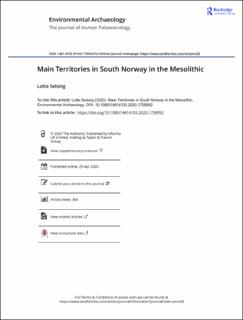| dc.contributor.author | Selsing, Lotte | |
| dc.date.accessioned | 2021-04-22T13:33:12Z | |
| dc.date.available | 2021-04-22T13:33:12Z | |
| dc.date.created | 2020-11-12T09:45:54Z | |
| dc.date.issued | 2020-04 | |
| dc.identifier.citation | Selsing, L. (2021) Main Territories in South Norway in the Mesolithic. Environmental Archaeology, 26(1), 75-98. | en_US |
| dc.identifier.issn | 1461-4103 | |
| dc.identifier.uri | https://hdl.handle.net/11250/2739184 | |
| dc.description.abstract | The focus of this paper is on regionality, the use of main territories and how they are interlinked in the Mesolithic in south Norway during the culmination of the settlement of the mountain area, 8500–7600 cal BP. The main territories and their boundaries are identified by the distribution of specific lithic raw materials and one artefact type, distribution of ungulates and drainage systems. In the Mesolithic, south Norway corresponds to a language family with four dialectic tribes, each one corresponding to a main territory. Based on ethnographic analogies, the inegalitarian higher latitude boreal hunter-gatherer societies had delayed return. The subsistence strategy may have included the defence of resources which were plentiful, concentrated and predictable, with ownership of resource-rich locations such as salmon runs and quarries, while unreliable resources such as unpredictable ungulates may not have been defended. Storing may have resulted in a sedentary period during the yearly round close to resource-rich areas along rivers and coasts. The presence of a cemetery by the seashore at Hummervikholmen, indicates lineal descent groups, linking territories to funerary behaviour. Territorial lineages may have existed, with formal areas for disposal of the dead at least along resource-rich riversides and seashores. However, these may have been destroyed by erosion and other destruction processes. Lithic markers indicate that foragers from the four main territories maintained a network of links following the drainage systems and crossing the mountain area in the Central Main Territory, which was temporarily settled by people from the other main territories. Here, people from different directions could meet during the warm season hunting reindeer. In the river sources around the water divide areas, people may have had meeting places, exchanging information over large areas of south Norway. The activities at the meeting places were connected to a reindeer culture with long diasporic traditions reaching back to their origin at the lateglacial Continent. Reindeer are proposed to have had a central role in the grouping of the main territories. | en_US |
| dc.language.iso | eng | en_US |
| dc.publisher | Informa UK Ltd. (Taylor & Francis) | en_US |
| dc.rights | Attribution-NonCommercial-NoDerivatives 4.0 Internasjonal | * |
| dc.rights.uri | http://creativecommons.org/licenses/by-nc-nd/4.0/deed.no | * |
| dc.subject | arkeologi | en_US |
| dc.subject | mesolitikum | en_US |
| dc.subject | etnografisk arkeologi | en_US |
| dc.title | Main Territories in South Norway in the Mesolithic | en_US |
| dc.type | Peer reviewed | en_US |
| dc.type | Journal article | en_US |
| dc.description.version | publishedVersion | en_US |
| dc.rights.holder | © 2020 The Author(s). | en_US |
| dc.subject.nsi | VDP::Humaniora: 000::Arkeologi: 090::Nordisk arkeologi: 091 | en_US |
| dc.source.pagenumber | 75-98 | en_US |
| dc.source.volume | 26 | en_US |
| dc.source.journal | Environmental Archaeology | en_US |
| dc.source.issue | 1 | en_US |
| dc.identifier.doi | 10.1080/14614103.2020.1758992 | |
| dc.identifier.cristin | 1847267 | |
| cristin.ispublished | true | |
| cristin.fulltext | original | |
| cristin.qualitycode | 2 | |

